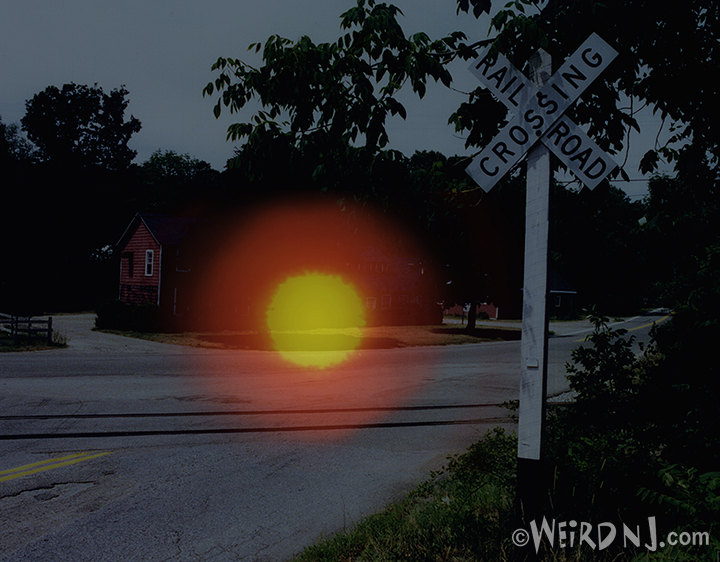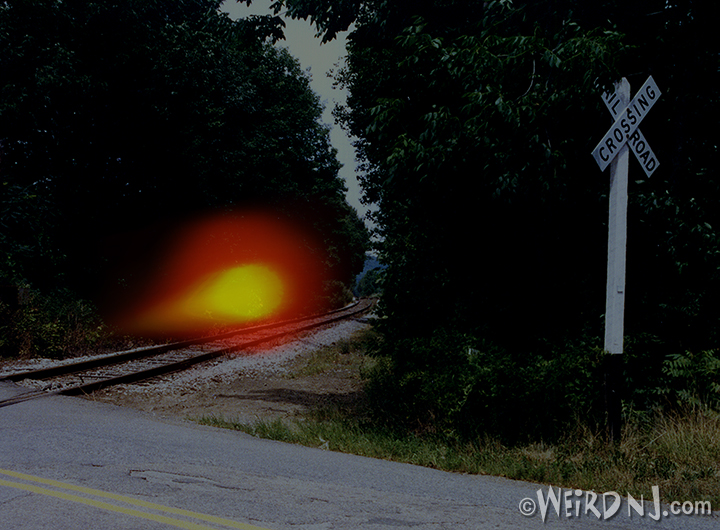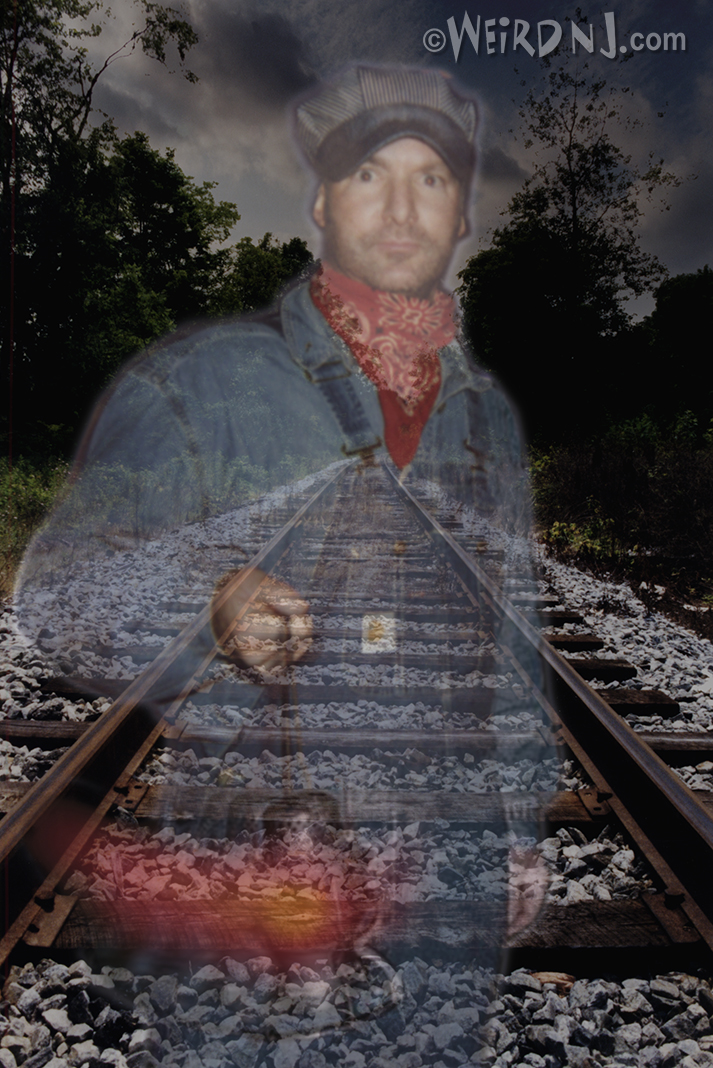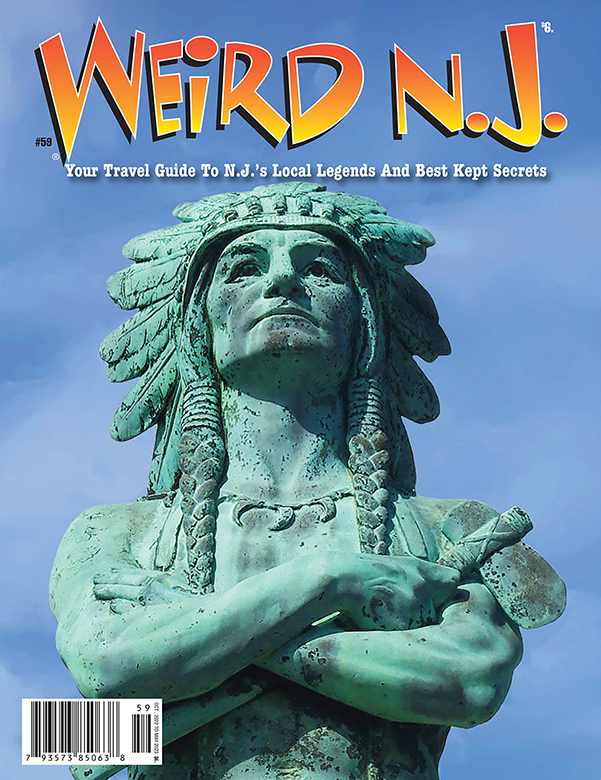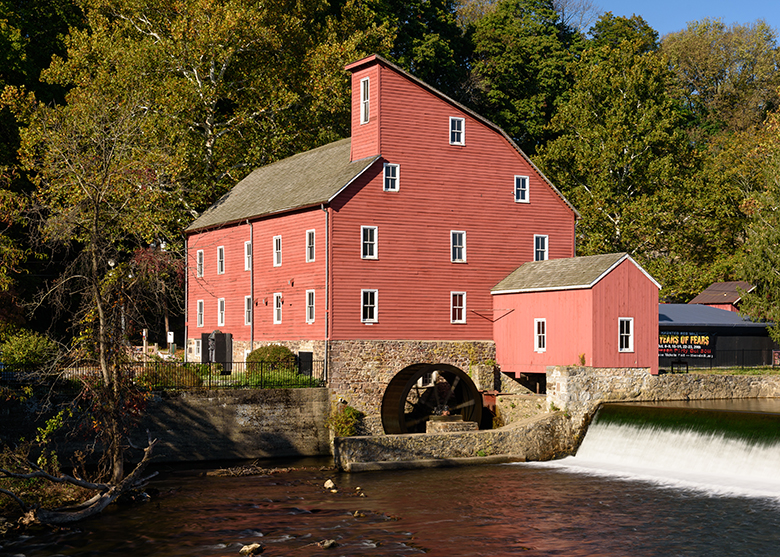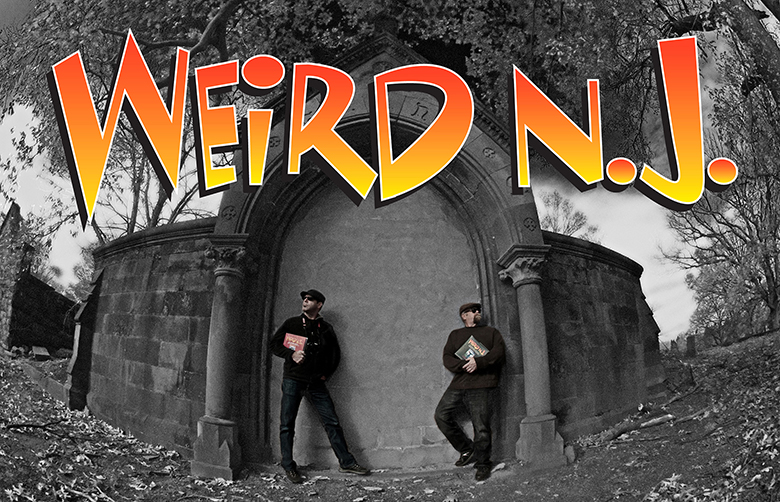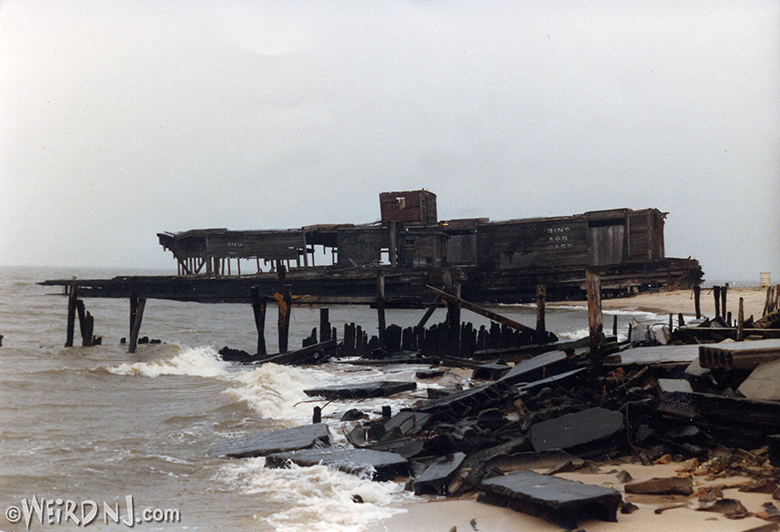The Hookerman Spook Lights of the Flanders Tracks
The scene is set: A moonless night, leafless branches swaying in the chilly November breeze. Through the mist ahead you see something: a dim white ball of light. It appears for a second, then dissipates into the dark. Suddenly, it appears again in a different spot, almost beckoning you to join whoever is up around the bend. In the distance you hear the sound of a faint whistle blow. Could a phantom train be riding on the track or is it just your imagination?
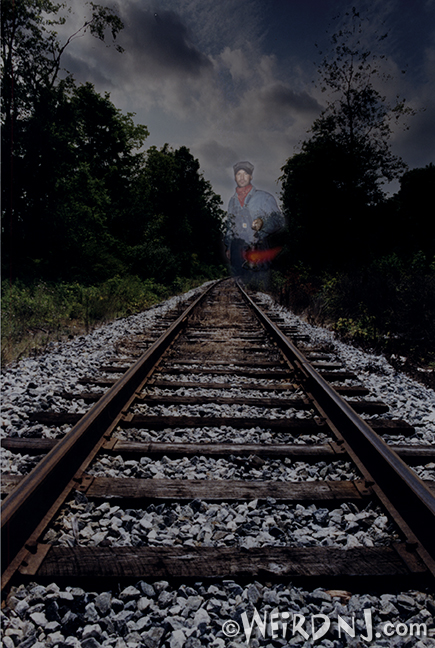 Just then the light appears to be coming down the tracks. Is it someone with a lantern, a flashlight? It starts to look like a bouncing ball. It gets brighter as it approaches, then passes over your head and fades into the dark.You’ve just witnessed what people around Flanders in Morris County called “The Hookerman.”
Just then the light appears to be coming down the tracks. Is it someone with a lantern, a flashlight? It starts to look like a bouncing ball. It gets brighter as it approaches, then passes over your head and fades into the dark.You’ve just witnessed what people around Flanders in Morris County called “The Hookerman.”
The legend of The Hookerman is a familiar tale amongst aficionados of the supernatural. The explanations have filled anomalous notebooks and magazines throughout the world. There are more than 60 different locations throughout the United States alone where this odd phenomenon occurs, and probably 100 different explanations for why it does. The spirits of long-dead railroad workers have become synonymous with these “spook lights.” Others take a scientific approach to the mystery. Many, but not all of these sightings are associated with railroad tracks. They also appear on open farmland and hillsides, and sometimes above water.
 In New Jersey, the Hookerman legend is that of a railroad worker who lost his arm in a train mishap over a century ago. Some say he was a night watchman on the Bartley/Flanders spur. One night while signaling the oncoming train to stop, he fell and lost consciousness. When he awoke, he realized the train had run him over and cut off his arm.
In New Jersey, the Hookerman legend is that of a railroad worker who lost his arm in a train mishap over a century ago. Some say he was a night watchman on the Bartley/Flanders spur. One night while signaling the oncoming train to stop, he fell and lost consciousness. When he awoke, he realized the train had run him over and cut off his arm.
Other stories say that he lost his arm when he fell off a train, and comes back to find his wedding ring that was on the hand of his missing arm. Now, fitting with a hook to replace his lost hand, the Hookerman’s spirit appears on the tracks carrying a lantern, still searching for his lost arm.
Not only does the Hookerman appear in Flanders on North Four Bridges Road, but Morris County also claims him on the Naughright Road railroad tracks in Washington Township. Hillsborough in Somerset County claims to view the Hookerman at abandoned railroad tracks off Roycefield Road, and other reports of the Hookerman are now coming in from Boonton and Budd Lake. Are these people really seeing the Hookerman all over the state, or is the well-known folk tale now just being associated with any set of abandoned tracks?
The Long Valley/Flanders site has actively reported the mystery lights for over a century along the tracks. Constructed in the mid-nineteenth century as a link between Chester and Long Valley, the railroad line carried iron ore, passengers and freight up until the 1930s. The appearance of the Flanders lights are almost identical to other sightings across the country. The light is often a dull yellow. The flickering effect is much like a lantern swinging from side to side.
Anthony Muller, a science teacher in Mt. Arlington has witnessed these lights on several occasions and offers an explanation of the occurrences:
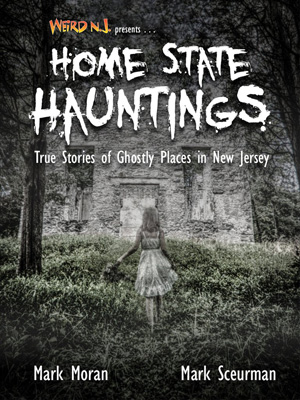 The effect is a bright, rose to amber colored light, ball-like or disc-like in shape with a diameter of about four feet. It seems to be 10 to 12 feet above the tracks and moves in one direction up the tracks. I would estimate its speed at 25 to 40 mph. I was quite interested in this phenomenon and began some research.
The effect is a bright, rose to amber colored light, ball-like or disc-like in shape with a diameter of about four feet. It seems to be 10 to 12 feet above the tracks and moves in one direction up the tracks. I would estimate its speed at 25 to 40 mph. I was quite interested in this phenomenon and began some research.
For an explanation I turned to geologists and electrical engineers who told me quartz-bearing rocks, under pressure and stress will produce electrical discharges in what is known as the pieco-electric effect. I believe that the railroad tracks may act as an antenna (as it were) to focus this electrical energy into that most elusive of phenomena, “ball lightning” (or at least something close to it).
The NJ-based organization Vestigia had conducted a intensive study in 1976 of the Long Valley mystery lights. Research director of the Parapsychology Division Peter Jordan co-authored an article on their findings, which proved beyond all doubt that the cause was geophysical—and not supernatural.
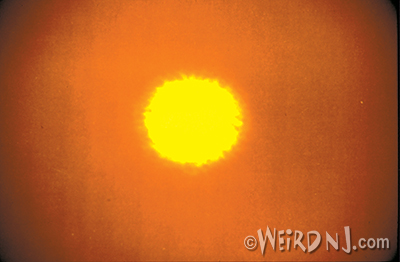 The group, led by Bill Wagner, studied the history of the area to see if there were any documented connections between railroad deaths and the Hookerman. Many of the casualties they found involved mining and railroad tragedies, but the cases failed to reveal any incident where an arm was amputated.
The group, led by Bill Wagner, studied the history of the area to see if there were any documented connections between railroad deaths and the Hookerman. Many of the casualties they found involved mining and railroad tragedies, but the cases failed to reveal any incident where an arm was amputated.
After talking to the local population about the Hookerman, Vestigia learned several accounts had ol’ Hooker hospitalized at a local institution for the insane after the accident. Local hospital records and railroad documents failed to bring a link between the true identity of the legend of Long Valley.
On Nov. 20, 1976, the first experiments of the Vestigia team began, with three outposts set up for observation. The groups were composed of experts in meteorology, physics, optics, photography and chemistry. 4,000 feet of copper wire was laid between the rails and attached to amplifiers and oscilloscopes to record variations of electrical frequency. A Geiger counter was put at ground zero. Equipped with methane detectors and parabolic listening devices (which the members made themselves), the team was ready to meet the Hookerman.
At 10pm drastic changes occurred on their instruments. A small distinct light appeared five to six inches in diameter. It hovered over the tracks about a foot above the ground. Cameras went off, and their devices measured dramatic reactions. Whatever they were seeing was capable of changing the electrical activity in the area. The light appeared for approximately two minutes then disappeared. During the next 15 minutes, the devices used to record the event showed active readings above and beyond normal readings.
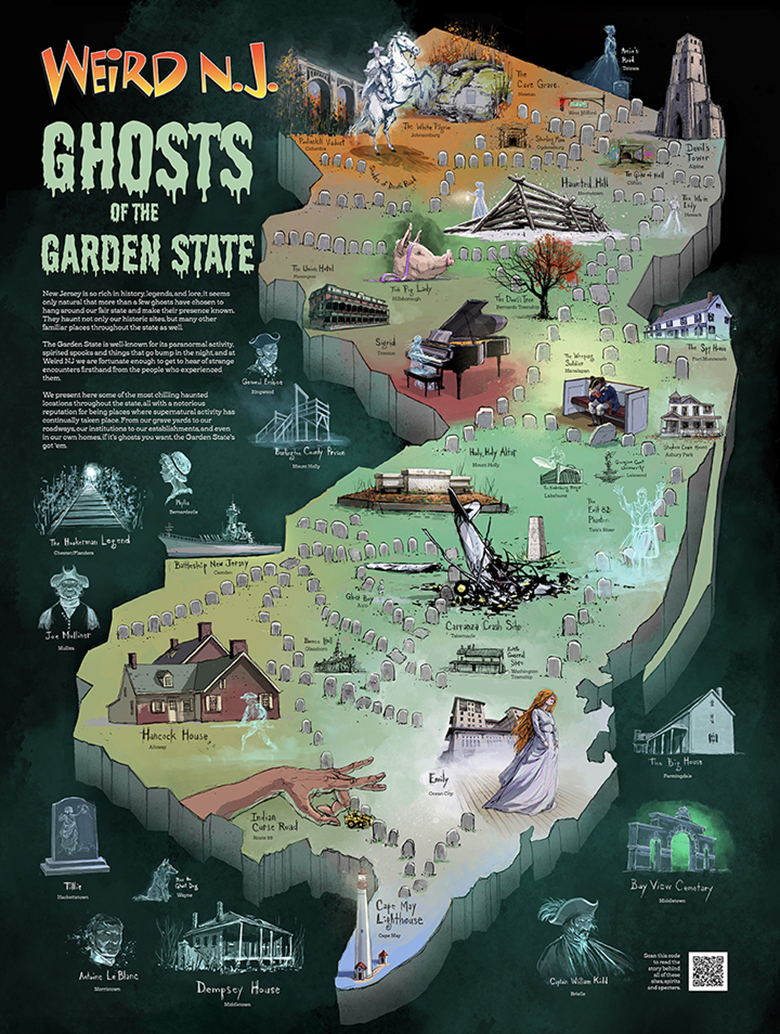 The photographs revealed different images in black and white, and infra-red film. The black and white film showed a pinpoint of light, while the infra-red produced a more detailed picture, showing more density and light range of the object.
The photographs revealed different images in black and white, and infra-red film. The black and white film showed a pinpoint of light, while the infra-red produced a more detailed picture, showing more density and light range of the object.
With all the experiments conducted at the site, the Vestigia team turned to geophysical science for an explanation. The geodesic maps of New Jersey revealed a major fault, the Ramapo Border Fault that runs through Peapack and ends at Indian Point, N.Y. Since 1962 there have been no less than 33 minor earthquakes along this fault, with a sizable amount around the Long Valley area.
Certain quartz-bearing rock are subject to stress from the earth, and as a result, produces electrical results, similar to sound waves that produce electrical responses in crystals such as microphones and telephones. The railroad bed in Long Valley is composed of granite, a very good conductor of electricity. Vestigia’s further research revealed the Hookerman would appear persistently, and predictably precede reports of local earthquake activity.
Conrail, who owns the railroad bed property in Flanders, decided to rip up the tracks in 1977, against the wishes of Vestigia who thought the rails were essential to solving the ghost light phenomenon. The decision to uproot the tracks was made because of the many people who would show up on the property looking for the Hookerman lights. Conrail did not want to take the responsibility of anyone getting hurt or losing arms along the railroad bed.
Fortunately for New Jersey nightriders, the explanation of the Hookerman doesn’t damper the mystique of the legend, as long as there is a place to drive to and possibly see the ghost lights. New Jerseyans are still setting out to find the Hookerman along the backroads of Flanders and other locations, as they have done for over a century.
Encountering The Hookerman
I’m from Sussex County, and I want to tell you about my experience with the Hookerman. Three of my friends and I went down to Four Bridges Road in Chester to look for the Hookerman. We parked where the railroad tracks would have crossed and headed down the abandoned bed. We got our share of headlights from cars that we could see way down the bed, you know, “there he is! Oh no it’s not.” Then a few minutes later we thought a car was coming down the tracks until the four bright lights merged into one then headed down the bed towards us. It got real faint as it got closer. We were freaked out, but at the same time really excited. It was the Hookerman!
As it came closer to us, like morons we ran for that foggy light. We got within about 20 feet or so then it disappeared. We thought that was it. As we looked down the bed past the car it reappeared. We ran towards the car, past the car, down the bed on that side of the road. It had disappeared again. This part really scared the living crap out of us. We looked back at the car and the light was doing loops around it. The light started as that foggy light, changed to a green, then bright red, then shot up about 10 feet and disappeared for good.
Three out of four of us swear on our granny’s graves on what we saw. The fourth is in denial. He says the bright lights coming down the bed at first was a helicopter, and the light looping around HIS car was a radar detector! Go figure. –Don in Andover
Hookerman May be Just a Lot of Gas
There used to be a Central Railroad of NJ line from High Bridge to Greenwood Lake Junction (where it met the Lackawanna). This line finally closed in about 1974, I think, and the tracks were ripped out west of Flanders.The Morristown and Erie RR operates these tracks with their locomotives that come up from Morristown through Dover and Kenvil.
The line was fairly active for many years with freights and the occasional passenger excursion. Sometime in the early part of this century, a track worker was supposed to have been killed by a train. Since then he has been haunting the old line with a lantern in the area between Flanders and High Bridge, with many sightings around Bartley and Long Valley. People see a glow in the air along the old right of way, which runs through the woods, and is now a hiking trail with a gas pipeline underneath.
Some say that the explanation is gas leaking from the pipeline, but people have seen the Hookerman years before the pipeline was installed. I read somewhere that Rutgers University had done some tests on the tracks and that a possible reason for the lights was the same phenomenon that makes spearmint Lifesavers emit sparks when you chew them in the dark: triboluminesence.
Triboluminesence is a photoelectrical phenomenon found in many materials, in which strain (striking the material, for example) produces a flash of light. It is believed that TL is, in some cases, just another manifestation of fluorescence or phosphorescence already present in the material, and is stimulated by the strain. In the Hookerman case, Rutgers speculates that there small tremors or earthquakes happening that strain the rocks under the roadbed that cause the glow.
Anyway, it’s a cool recurring story. –David Goessling, Technical Information Analyst
Hunting for the Hookerman
Back in the 1960’s and 1970’s, the Hookerman site was a big teen attraction. A friend of mine would often go down to see the lights, and on hot summer nights, there would always be a crowd of 15-30 teens! The Hookerman, he said, generally appeared right before a train was to pass by. Usually it appeared as a yellowish hazy ball that bobbed about the tracks. One particular night, however, he became a true believer. As a train approached at its requisite 10 MPH speed on this somewhat rickety line, the Hookerman light appeared about 30 feet down the tracks from where they were standing. The train got closer, and the light moved down the tracks slowly as well. Just before the train reached the group, the engineer dimmed his headlight for a second, then turned it on again at its highest brightness. For about a second, in the rays of the bright light, the group saw a translucent figure of a railroad worker in overalls with one arm, and that arm was waving a lantern side to side.
As the train passed, a train crewman stuck his head out of the window and shouted to the group, “Holy shit! Did you see that?” The second the train’s caboose rolled past, the group started running towards their cars.
One last intriguing fact: In the 1920’s and 1930’s, the Central Railroad of New Jersey (whose tracks these were) had a notation in their employee timetable “not to stop for any lantern signals” in this area–that’s how common the Hookerman lights were! –Paul Tupaczewski
The preceding article is an excerpt from Weird NJ magazine, “Your Travel Guide to New Jersey’s Local Legends and Best Kept Secrets,” which is available on newsstands throughout the state and on the web at www.WeirdNJ.com. All contents ©Weird NJ and may not be reproduced by any means without permission.
Visit our SHOP for all of your Weird NJ needs: Magazines, Books, Posters, Shirts, Patches, Stickers, Magnets, Air Fresheners. Show the world your Jersey pride some of our Jersey-centric goodies!
Now you can have all of your favorite Weird NJ icons on all kinds of cool new Weird Wear, Men’s Wear, Women’s Wear, Kids, Tee Shirts, Sweatshirts, Long Sleeve Tees, Hoodies, Tanks Tops, Tie Dyes, Hats, Mugs & Backpacks! All are available in all sizes and a variety of colors. Visit WEIRD NJ MERCH CENTRAL. Represent New Jersey!
![]()

